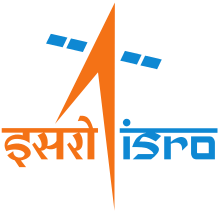IRNSS-1G
| Mission type | Navigation | ||||
|---|---|---|---|---|---|
| Operator | ISRO | ||||
| Mission duration | 12 years | ||||
| Spacecraft properties | |||||
| Bus | I-1K | ||||
| Manufacturer |
ISRO Satellite Centre Space Applications Centre | ||||
| Launch mass | 1,425 kilograms (3,142 lb) | ||||
| Power | 1,300 W[1] | ||||
| Start of mission | |||||
| Launch date | 28 April 2016 12:50 IST | ||||
| Rocket | PSLV-XL C33 | ||||
| Launch site | Satish Dhawan (First) | ||||
| Contractor | ISRO | ||||
| Orbital parameters | |||||
| Reference system | Geocentric | ||||
| Regime | Sub-Geosynchronous Transfer Orbit (sub-GTO) | ||||
| Perigee | 284 km (176 mi)[1] | ||||
| Apogee | 20,657 km (12,836 mi)[1] | ||||
| |||||
IRNSS-1G was the seventh and final[2] of the Indian Regional Navigation Satellite System (IRNSS) series of satellites after IRNSS-1A, IRNSS-1B, IRNSS-1C, IRNSS-1D, IRNSS-1E and IRNSS-1F. This system of satellites will provide navigational services to the Indian region. The satellite was placed in geosynchronous orbit successfully on April 28, 2016 at 12:50–pm IST.[2]
Launch
The satellite was launched from the First Launch Pad (FLP) of Satish Dhawan Space Centre, Sriharikota on board PSLV-C33.[2] The countdown of the launch had begun 51:30 hours before at 9:20 a.m. IST on 25 April.[3]
After the launch of IRNSS-1G Prime Minister of India, Narendra Modi declared that the IRNSS system would be called NAVIC (Navigation Indian Constellation). He also stated that other countries of the Indian subcontinent could use the IRNSS system as they are currently dependent on other nation's navigational systems.[2] The system thus also holds strategic importance in Modi's foreign policy. Rajeswari Pillai Rajagopalan, the head of the space policy initiative at Observer Research Foundation said that IRNSS would provide freedom to India during potential conflicts as it currently depends on America's Global Positioning System (GPS) and Russia's GLONASS.[4]
Specifications
The satellite is designed for 12 years of life.[3] It has a lift-off mass of 1,425 kilograms (3,142 lb) and dry mass of 598 kilograms (1,318 lb).[1] The ranging payload of IRNSS-1G consists of a C-band transponder (automatic receivers and transmitters of radio signals) which facilitates accurate determination of the range of the satellite.[5] It would operate in L-5 and S band spectrums and also has a Rubidium atomic clock.[6] Special thermal control systems are used for key components like this clock. Two panels of solar cells are used to generate 1660W of energy and one Litium-ion 90A-hr battery is used.[1] The satellite is placed in an orbit at an altitude of 497.8 kilometres (309.3 mi) at 129.5 deg East longitude.[1][7] It cost approximately ₹125 crore (US$19 million).[4]
The "XL" version of PSLV was used with six strap-ons for the launch. Each strap-on used 12 metric tons (12 long tons; 13 short tons) of propellant. ISRO has successfully used PSLV 34 times and the XL version 12 times before the launch of IRNSS-1G.[8]
See also
- Communication-Centric Intelligence Satellite (CCI-Sat)
- GPS-aided geo-augmented navigation (GAGAN)
- Satellite navigation
References
- 1 2 3 4 5 6 "PSLV-C33 - IRNSS-1G Specifications" (PDF). ISRO. Retrieved 28 April 2016.
- 1 2 3 4 "India launches seventh navigation satellite, to get its own GPS". The Hindu. April 28, 2016. Retrieved April 28, 2016.
- 1 2 PTI (26 April 2016). "Countdown for IRNSS-1G launch begins at Sriharikota". The Hindu. Retrieved 28 April 2016.
- 1 2 Vanita Srivastava (1 May 2016). "IRNSS: Desi GPS to liberate India from dependence on US, Russia". Economic Times. Retrieved 2 May 2016.
- ↑ "'Isro launches rocket carrying India's seventh navigation satellite'". Business Standard. April 28, 2016. Retrieved April 28, 2016.
- ↑ "IRNSS-1G". ISRO. Retrieved 28 April 2016.
- ↑ Sangeeta Ojha (28 April 2016). "India's own navigation satellite IRNSS-1G launched: All you need to know about it". India Today. Retrieved 28 April 2016.
- ↑ "PSLV-C33/IRNSS-1G". ISRO. Retrieved 28 April 2016.
